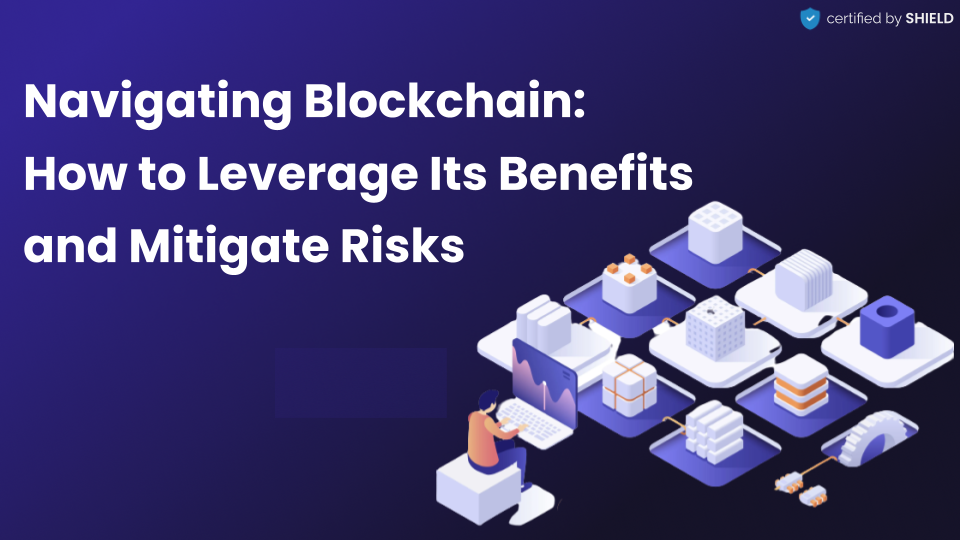Navigating Blockchain Technology: How to Leverage Its Benefits and Mitigate Risks
Isaiah Udotong (COO/Cofounder) • 2023-04-19
Introduction:
Blockchain technology introduces revolutionary changes on how we store and share information. Similar to how information sharing innovation of the Internet led to massive societal change, blockchain technology will transform any industry where it is adopted.
However, great innovation often presents new challenges, and for blockchain, it is a growing number of scams. In this blog post, we'll explore the benefits of blockchain technology, the risks, and the ongoing work to make the ecosystem safer.
What is Blockchain technology and what Tangible Benefits are there?
Blockchain technology can be understood simply as a big open-source computer in the cloud. This virtual computer runs on a multitude of physical computers owned by different sets of people. This sounds simple but is quite revolutionary because in the past computer systems and records have been controlled by single owners and companies. Blockchain is a shared record-keeping system that no single party owns.
Blockchain's basic design principles enable a great degree of innovation:
Decentralization: By eliminating the need for central authorities, blockchain technology eliminates the risk of the network acting against users.
Example: Bitcoin uses a decentralized network, so nobody can reverse transactions, freeze accounts, or stop people from using it.
Security: Cryptography plays a crucial role in safeguarding information by allowing only authorized individuals to access and comprehend it.
Example: Only authorized individuals in possession of the right public/private keys can access and transfer funds for an account.
Transparency: All transactions are recorded on a public record book, which promotes trust and accountability among participants.
Example: Ethereum's Etherscan allows all users to view transaction records and details. This would be like Chase Bank letting you see all the transactions Person A sent Person B.
Immutability: Once information is saved on the blockchain, it's like writing with a permanent marker – you can't change it. This makes sure that nobody can mess with the information, keeping it safe and trustworthy.
Example: The InterPlanetary File System (IPFS) leverages the blockchain's immutability to store and distribute files, text, images, video without the risk of censorship or data manipulation.
Reduced costs: Blockchain can make things faster and cheaper by cutting out middlemen in transactions between 2 parties.
Example: Ripple's XRP facilitates cross-border payments at a fraction of the cost and time compared to traditional banking systems.
Why do I hear so much about scams with crypto?
The very nature of blockchain and cryptocurrencies has attracted malicious actors looking to exploit vulnerabilities in the ecosystem. Some reasons for the prevalence of scams include:
Allure of Unprotected Assets: Organizations with assets on blockchain, can look to a scammer like an online bank vault, but without the enterprise-level security measures that a bank would have.
Example: Very sophisticated scammers targeted and successfully exploited over $600M for Ronin Network after a long period of monitoring and finding an opening to the transparent location the assets were stored
Anonymity: Cryptocurrencies often enable hiding your identity with no KYC, so it's easier for scammers to hide and not get caught.
Example: Many cryptocurrencies have been used to receive illicit funds due to their anonymous nature, making it difficult for authorities to trace the perpetrators.
Technical complexity: Blockchain and cryptocurrencies can be hard to understand, so people might not realize when something is a scam.
Example: Some scammers make fake wallet apps that look like real ones, tricking people into sending money to the wrong place.
High returns: The potential for high returns on investment can make investors more susceptible to scams and fraudulent schemes.
Example: Similar to during the dotCom bubble, the 2017 Initial Coin Offering (ICO) boom led to numerous fraudulent projects, as investors, lured by the promise of high returns, poured money into dubious ventures.
What can be done to stop these scams?
To combat scams and ensure the safety of the blockchain ecosystem, a multi-pronged approach is needed. Some solutions include:
Auditors: These are experts who check if things on the blockchain are safe and working right. They help stop bad things from happening.
User education: Teaching people about scams and how to stay safe can help them avoid problems.
Regulatory oversight: Governments and regulatory bodies can establish rules and guidelines to protect users and hold bad actors accountable.
Companies developing innovative solutions: Some companies, like Shield, are making tools and software to help make blockchain safer for everyone.
Conclusion
Blockchain technology has the potential to transform industries and improve lives, but it is not without its challenges. By understanding the risks and working together to create innovative solutions, we can build a more secure ecosystem and realize the benefits of this new technology
See More Posts
Copyright © 2023 Shield Security, Inc. All rights reserved.




